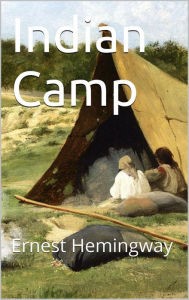Dissemination
Indian Camp - Methodology
Written by Super UserTitle of Activity
INDIAN CAMP, Ernest Hemingway
Description of educational activity
Duration: 1 X 45 minutes
Pupils’ age: 15-19
Organization of the class of pupils: group work
The aim of the lesson: The aim of the lesson is to motivate the students to read in the way that reading comprehension enables them to understand the relations between the characters – white doctor and an Indian woman suffering, the issue of struggling and enduring pain.....
Another goal is to enable Ss develop their miming skill to present a story according the given guidelines without having read it.
Ss will gain knowledge and understanding of a famous 20 century writer and his opus of short stories.
Support materials:
Handouts :
- a short summary
- characters description
- guidelines for pantomime
Activities:
- The Ss are divided in two groups – The “mime” and the “readers”
- The mime group is given the handouts – they are going to mime the story
- The “readers” group is going to “read” the interpretation
- The mime group Ss read the guidelines and pick a role
- The mime group gets 3- 5’ to read the guidelines
- The mime Ss present the story
- The readers “read” what the actors are presenting
- All Ss are given the story to read and check whether they have understood the plot.
Evaluation and assessment method:
Throughout the lesson, the Ss will be very active to present VS understand the mime.
Teacher’s role - monitoring Ss’ work, their interaction, reading for details, making notes, and participation in group activities.
In order to evaluate and assess the effective impact of the previous activities upon the students, they are asked to elaborate a short paper in no more than 5 minutes where they make an In-depth analysis of the main characters and their relationships
Effect of the activity on RSP reading: Practices that support students´ choice, collaboration, and shared control of learning outcomes can be linked to self-expressed interest in reading and engaged reading behaviours.
Teachers can organize reading instruction to develop self-efficiency, competence, and engagement in teenage students.
Connection to curriculum
Grade: 3rd grade
Curriculum:
Civic education – responsible behaviour, developing empathy, understanding the position of deprived minority women, (in)ability to endure someone’s suffering, fear, growing up,
World Literature - classics works of art - reading and valuing
History – Indian culture , related to reality,
Knowledge:
- Understand the relationships in different culture
- Develop reading fluency
- Improve reading comprehension
- Organise information in a specific way
Skills:
- Use handouts incentive
- Make predictions
- Compare and contrast
- Summarize
- Work effectively in groups, cooperation
Competences:
- Make connections between unknown culture and your own
- Be able to visualise material read
- Follow instructions and present them visually
- Evaluate evidence
- Support and justify an opinion
Bibliographic reference to be used during the activity
Ernest Hemingway
Indian Camp
Publisher:
ISBN:
Page count:
Year of issue:

Digital sources
-
Results
The expected outcomes of the lesson are:
The students will be able:
- to understand the task by reading the guidelines.
- to connect ideas.
- to present different characters,
- to make connections and make a story,
- to evaluate the relationship between the characters,
- to justify their reactions
- to speculate,
- to interpret.
Recommendations
Both the teaching method and the text can help in increasing Ss’ interest in reading. This text promotes the consciousness of treating a minority group members.
The teacher monitors the students so as to make sure they cooperate effectively.
The short story can be adapted to the language level of a group – it can be shorter - by cutting less important sentences regarding descriptions, or be expanded to additional fragments of the same short story. Students can be offered a glossary of difficult vocabulary.
